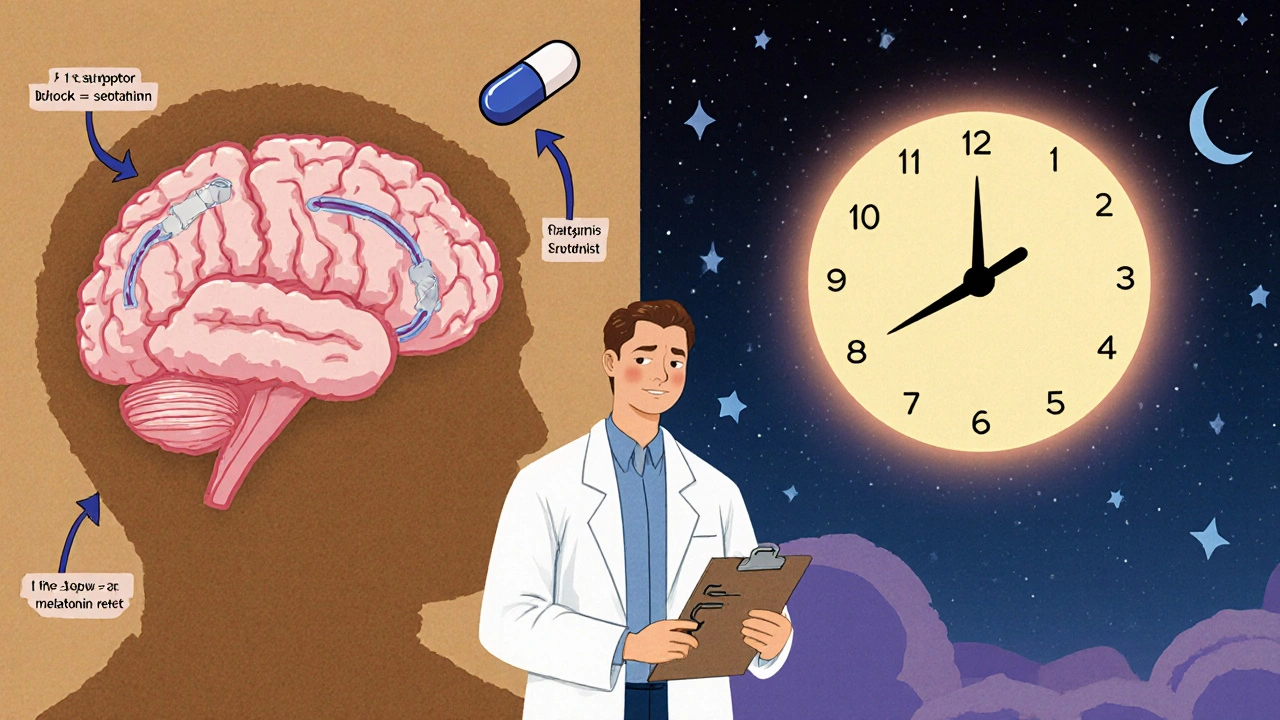Doxylamine Succinate vs. Common Sleep Aids: Detailed Comparison
 Oct, 22 2025
Oct, 22 2025
Sleep Aid Selection Tool
Answer a few quick questions to find the sleep aid that's best for you based on the latest medical guidance.
When you’re hunting for a night‑time remedy, Doxylamine often shows up alongside melatonin, diphenhydramine, and a handful of herbal options. But how does it really stack up? This guide walks through the science, side‑effects, onset time, and best‑use scenarios for Doxylamine succinate and its most popular alternatives, so you can pick the right match for your sleep pattern.
What is Doxylamine Succinate?
Doxylamine succinate is a first‑generation antihistamine that crosses the blood‑brain barrier and produces strong sedative effects. It was introduced in the 1960s as a component of over‑the‑counter sleep aids such as Unisom SleepTabs. The drug blocks histamine H1 receptors, which quiets the brain’s arousal pathways and encourages drowsiness. Typical adult dosing for insomnia is 25 mg taken 30 minutes before bed, and the half‑life ranges from 10 to 12 hours, meaning residual grogginess can linger into the morning if taken too late.
How Do Common Alternatives Work?
Below are the leading contenders you’ll see on pharmacy shelves or health‑store aisles. Each has a distinct mechanism that influences how quickly you fall asleep, how long the effect lasts, and what side‑effects you might expect.
- Diphenhydramine - another first‑generation antihistamine (found in Benadryl and many “PM” pain relievers). It works like Doxylamine but generally has a slightly slower onset.
- Melatonin - a naturally occurring hormone that regulates the circadian rhythm. Supplements provide the hormone directly, nudging the body’s internal clock.
- Valerian root - an herbal extract that may increase GABA activity, the brain’s primary inhibitory neurotransmitter.
- Hydroxyzine - a prescription antihistamine often used for anxiety and short‑term insomnia.
- Cetirizine - a second‑generation antihistamine typically taken for allergies; it has mild sedative properties but is less drowsy than first‑generation agents.
- Loratadine - another second‑generation antihistamine with minimal sedation, sometimes used off‑label for mild sleep trouble.
Head‑to‑Head Comparison Table
| Attribute | Doxylamine Succinate | Diphenhydramine | Melatonin | Valerian Root | Hydroxyzine |
|---|---|---|---|---|---|
| Drug class | First‑gen antihistamine | First‑gen antihistamine | Hormone supplement | Herbal anxiolytic | Prescription antihistamine |
| Typical dose for insomnia | 25 mg | 25-50 mg | 0.5-5 mg | 400-900 mg extract | 25-50 mg |
| Onset of sleep (minutes) | 30-45 | 45-60 | 15-30 (if taken early) | 30-60 | 30-45 |
| Half‑life | 10-12 h | 4-6 h | 30-60 min | 2-4 h | 20-25 h |
| Next‑day grogginess | Medium-High | Medium | Low | Low-Medium | Medium-High |
| Common side‑effects | Dry mouth, constipation, anticholinergic load | Drowsiness, dry mouth, blurred vision | Headache, dizziness | Stomach upset, headache | Dry mouth, dizziness, hypotension |
| OTC availability (US) | Yes | Yes | Yes | Yes (as supplement) | Prescription only |
| Typical cost (per dose) | $0.10-$0.20 | $0.12-$0.25 | $0.05-$0.15 | $0.08-$0.20 | $0.30-$0.50 (prescription) |
When Doxylamine Is the Right Choice
If you need a powerful, fast‑acting sleep aid and you’re okay with occasional morning fog, Doxylamine is a solid pick. Its strong antihistamine action works well for people who have trouble falling asleep due to an overactive mind or mild allergic symptoms that keep them awake. Because the half‑life is relatively long, it’s best used when you have at least 7-8 hours of sleep time. Shift‑workers who nap during the day should avoid it, as the lingering sedation can interfere with daytime alertness.

Scenarios Where Alternatives Shine
Not everyone tolerates first‑generation antihistamines well. Below are common situations and the alternative that tends to perform best.
- Gentle bedtime routine for older adults - Melatonin is often recommended because it mimics the body’s natural hormone and carries a low risk of anticholinergic side‑effects (dry mouth, urinary retention) that older people are prone to.
- Allergy sufferers who also need sleep - Cetirizine or Loratadine can provide mild sedation without the heavy anticholinergic load, making them suitable for daytime allergy relief that doubles as a night‑time aid.
- People with anxiety‑related insomnia - Hydroxyzine, prescribed at low doses, calms both anxiety and the brain’s arousal system, offering a two‑in‑one benefit.
- Natural‑product fans - Valerian root offers a plant‑based route; studies show a modest reduction in sleep latency, especially when taken 30 minutes before bed.
Safety Concerns and Drug Interactions
First‑generation antihistamines, including Doxylamine and Diphenhydramine, share a risk profile that warrants caution. Their anticholinergic activity can interact with other medications that also have dry‑mouth or urinary‑retention side‑effects, such as tricyclic antidepressants, antipsychotics, and certain muscle relaxants. Mixing them with alcohol magnifies sedation and impairs motor coordination dramatically. For people with glaucoma, enlarged prostate, or severe liver disease, consult a physician before using these agents.
Melatonin is metabolized by the liver enzyme CYP1A2; drugs that inhibit this enzyme (e.g., fluvoxamine) can raise melatonin levels and cause excessive drowsiness. Herbal extracts like valerian can potentiate the effects of benzodiazepines or barbiturates, so co‑administration should be discussed with a clinician.
How to Choose the Best Option for You
Use the following checklist to narrow down the right sleep aid:
- Desired onset time: Need to fall asleep within 30 minutes? Choose melatonin or Doxylamine.
- Risk of next‑day grogginess: If you need to be sharp in the morning, lean toward melatonin, valerian, or a second‑generation antihistamine.
- Medical history: Chronic glaucoma, prostate enlargement, or cognitive decline? Avoid first‑generation antihistamines.
- Medication list: Look for existing anticholinergic drugs or CYP‑interacting agents.
- Preference for natural vs. synthetic: Valerian and melatonin are plant‑derived; Doxylamine is a synthetic compound.

Practical Tips for Using Doxylamine Safely
Even if Doxylamine wins the comparison for you, follow these best practices to limit side‑effects.
- Take the tablet with a small amount of water, not a full glass of milk, to reduce the risk of stomach upset.
- Set a consistent bedtime; the drug works best when your circadian rhythm isn’t wildly shifting.
- Reserve Doxylamine for short‑term use (no more than 2 weeks) unless a doctor advises otherwise.
- Avoid driving, operating heavy machinery, or making important decisions until you know how the medication affects you.
- If you experience severe dry mouth, consider a sugar‑free gum or water‑based lubricants before bedtime.
Frequently Asked Questions
Can I combine Doxylamine with melatonin?
Mixing the two isn’t recommended unless a healthcare provider suggests it. Both promote sleep, but together they can increase the chance of morning grogginess and anticholinergic side‑effects.
Is Doxylamine safe for pregnant women?
The medication is classified as Category B in the US, meaning animal studies show no risk but there are no well‑controlled human studies. Doctors usually advise against routine use during pregnancy.
How does Doxylamine compare to prescription sleep drugs like zolpidem?
Zolpidem (Ambien) is a non‑benzodiazepine hypnotic that works directly on GABA receptors, offering a quicker onset and shorter half‑life. Doxylamine is less potent, over‑the‑counter, and carries fewer regulatory restrictions, but it also brings more next‑day drowsiness.
What’s the best time to take Doxylamine?
Take it 30 minutes before you intend to go to sleep, and make sure you have at least 7-8 hours of sleep opportunity ahead. Taking it later can cause morning fog.
Can I use Doxylamine daily?
Occasional use (a few nights a week) is generally safe for healthy adults. Daily use may lead to tolerance, dependence, and increased anticholinergic load, so a doctor’s supervision is advised for long‑term regimens.
Bottom Line
Doxylamine succinate delivers strong, reliable sedation and works well when you need a one‑night punch of sleep aid. However, its long half‑life and anticholinergic profile mean it isn’t ideal for everyone. If you’re sensitive to dry mouth, need to be alert the next morning, or have chronic health conditions, alternatives like melatonin, valerian root, or a second‑generation antihistamine often provide a gentler experience. Use the comparison table, check the safety notes, and match the drug to your personal sleep pattern for the best outcome.

Benedict Posadas
October 22, 2025 AT 17:09Yo! Doxylamine is a beast for crashin sleep 😴
Jai Reed
October 23, 2025 AT 21:43While the guide is solid, let's cut to the chase: Doxylamine is great for heavy‑hit insomnia, but beware the morning haze. Make sure you have a full 7‑8 hours in the tank; otherwise you’ll be dragging your feet at work. It’s also an anticholinergic, so anyone with glaucoma or prostate issues should steer clear. Pairing it with alcohol is a recipe for disaster – you’ll feel like you’ve got vodka in your veins. If you need a nightly helper, start low, track how you feel, and consult a doc if the fog sticks around.
Sameer Khan
October 25, 2025 AT 02:17From a pharmacological perspective, Doxylamine succinate belongs to the first‑generation H1 antagonist class, which means it readily crosses the blood‑brain barrier and exerts pronounced central sedation. The drug’s affinity for the H1 receptor is high, leading to rapid onset of drowsiness, typically within 30‑45 minutes of ingestion. However, its elimination half‑life of 10‑12 hours translates into appreciable residual plasma concentrations the following morning, especially when dosing occurs later in the night. This pharmacokinetic profile distinguishes it from diphenhydramine, whose half‑life is markedly shorter, resulting in a somewhat reduced next‑day burden. Melatonin, in contrast, functions as a chronobiotic, aligning the suprachiasmatic nucleus to the darkness cue rather than providing a blanket sedative effect. Valerian root operates via modulation of the GABAergic system, offering a milder hypnotic action that avoids the anticholinergic load associated with Doxylamine. The anticholinergic side‑effects-dry mouth, constipation, urinary retention-are particularly salient in the elderly, wherein cognitive impairment may be exacerbated by cholinergic deficit. Moreover, the drug’s interaction potential includes synergism with other anticholinergic agents such as tricyclic antidepressants, antihistamines, and certain antipsychotics. Alcohol amplifies the central depressive effects, raising the risk of respiratory depression and impaired motor coordination. In patients with hepatic insufficiency, the metabolic clearance of Doxylamine may be prolonged, necessitating dose adjustments. Dosing regimens recommend a single 25 mg tablet 30 minutes before bedtime, with a maximum of two consecutive nights for short‑term usage. The guideline to avoid daily use stems from concerns about tolerance development and the potential for rebound insomnia upon discontinuation. Clinicians often reserve Doxylamine for individuals who have exhausted non‑pharmacologic sleep hygiene measures yet require a potent, short‑term aid. Ultimately, the decision matrix should weigh onset speed, duration of action, side‑effect profile, and patient comorbidities to select the most appropriate agent. Therefore, individualized assessment remains the cornerstone of sleep‑aid selection.
WILLIS jotrin
October 26, 2025 AT 05:50Interesting breakdown. It reminds me that the “one‑size‑fits‑all” myth rarely holds in sleep pharmacology.
Kiara Gerardino
October 27, 2025 AT 10:24Wake up! If you’re still popping anticholinergics like candy, you’re flirting with cognitive decline. The medical community has long warned that chronic first‑generation antihistamine use is a slippery slope toward delirium in susceptible populations. Choose smarter, choose safer, or better yet, master the art of sleep hygiene before reaching for the next tablet.
Emily Collins
October 28, 2025 AT 14:57I’ve been on Doxylamine for a month during finals, and the morning fog was real enough to miss a lecture. Switching to melatonin cut the haze dramatically, though it took a bit longer to drift off. Just a heads‑up: keep an eye on your hydration; the dry mouth can be nasty.
Harini Prakash
October 29, 2025 AT 19:31Thanks for sharing your experience; many folks underestimate the impact of dry mouth on comfort. Staying hydrated and chewing sugar‑free gum can mitigate that side‑effect while you decide on the best aid.
Tammy Sinz
October 31, 2025 AT 00:05The comparative table is useful, but I wonder how the pharmacodynamics translate into real‑world sleep architecture. Specifically, does Doxylamine preserve REM sleep, or does it blunt it like other antihistamines? Also, the chronic anticholinergic burden could affect neurocognitive testing outcomes in older adults. A prospective study measuring polysomnography outcomes across these agents would be enlightening. Until then, clinicians must balance anecdotal efficacy with the long‑term risk profile.
Christa Wilson
November 1, 2025 AT 04:38Great rundown! 🌙✨ Keep the good sleep vibes flowing!
John Connolly
November 2, 2025 AT 09:12In short, Doxylamine offers strong, fast sedation but carries a higher chance of next‑day grogginess and anticholinergic side‑effects. Alternatives like melatonin or second‑generation antihistamines provide gentler profiles for those sensitive to those effects. Match the drug to your sleep window, health status, and personal tolerance. Always prioritize good sleep hygiene as the foundation.